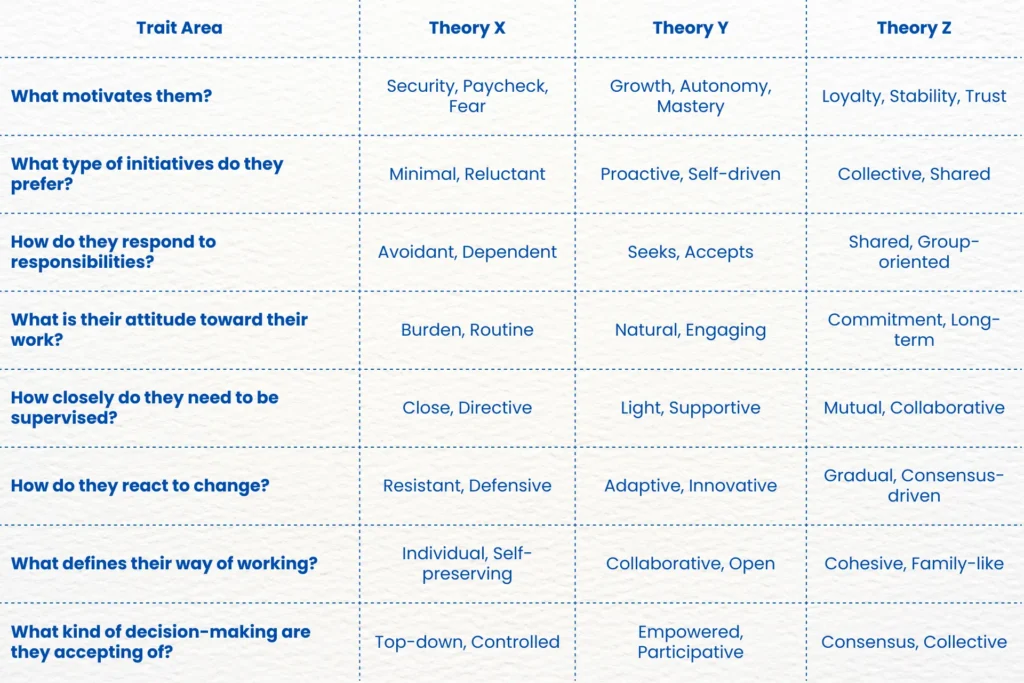Isn’t this something we would all like to know while working on our owned projects? Who all are our friends – can be trusted to handle their bits in the backlog timely and deliver quality output? Whereas, who are the lazy bums you need to stand over heads to get the work done? How do you identify these types in your project team? How to take care of them? How do you allocate priorities from the backlog in parallel to figuring out the experts in your team?
I agree – managing people surely is one of the toughest tasks to handle in project management. 🥺
Well, we’re in luck. Our previous generations have already figured out a mind-blowing way to achieve this. You likely came across this approach while studying for PMP or similar project management exams, because stakeholder management plays a huge part in project success.
And we call this… 10.
9.
8.
7.
6.
5.
4.
3.
2.
1…
Theory XYZ.
First lesson for you all:
Those who actually used this 10 second countdown to think about what it might be, you all fall into Theory Y. While those who scrolled down without thinking once to directly get the answer, well you’re into Theory X. And if you got curious and thought “wait, what could this be?” before peeking — welcome to Theory Z.
Want to know what makes me say this with certainty? Below is the answer.
Understanding Theory XYZ
Not explicitly designed for project management but as a management style to represent the types of people we connect with on a regular basis. Theory XYZ is a hybrid of Theory X & Y introduced by Douglas McGregor, and Theory Z gifted to us by William Ouchi – a wise professor and author in business management domain.
Theory X assumes people to be filled the following qualities:
- They dislike work and tend to avoid it.
- They must be coerced or controlled in order to get them to work.
- They prefer to be directed; may it be consciously or sub-consciously.
Whereas, Theory Y represents completely opposite people with qualities as:
- Curious to learn and reflect.
- Consider working as a natural and potentially fulfilling task.
- Can self-direct when committed; represent self-resilience.
- They seek and accept responsibility by own choice.
Lastly, Theory Z represent a completely different set of people who prioritize security. Qualities to find here:
- They tend to seek long-term employment and stability.
- They prefer to be part of collective decision-making; not as a sole responsibility.
- Some traits you can always count on them for – loyalty, trust, and holistic concern.
Getting exciting, right? The best part of this approach? All 3 theories quote different personality types with no conflicting traits that might complicate the team-handling strategy!
Who can benefit from this concept?
Before answering this, let me share one of my understandings based on a decade of experiences.
“Not all managers have what it takes to be leaders.”
You may find organizations be impacted with toxicity and teams holding the management accountable in such a scenario. Well to be truthful, YES. The management generally is accountable for a poorly handled project because they set their mind toward “getting work done” and “impressing senior stakeholders by showing control”.
To quote a recent example I came across through a mentee – the project team hired was told in their induction to be collaborative, to ask questions in group meets for good brainstorming sessions and improved understanding of the process. However, when a team member tried asking a process-related question in a daily stand-up, they were criticized by the manager with no answer stating “you need to be more attentive in these meetings to not make me repeat things”.
Result? Missed opportunity to learn. Demoralized team member. Other team members beginning to act more cautious before asking anything so as to not be made a bad example out of. Finally, poor project environment.
If there were a leader in the place of this manager, the response might’ve been something like “That’s a great question and maybe we could use your idea to take team’s knowledge a level up. Let me gather complete understanding of the idea and get back to you all in our next meetup.”
Well… isn’t this uplifting? Would you agree that this communication approach might have a positive outcome but certainly no negative ones? And this communication marks exactly the difference between a management individual and a leader.
Theory XYZ is meant for you if your goal is to be a leader; not just another project manager. Assumptions in here teach you about how to be a people’s person, i.e., knowing what inspires which type of individual to perform their best at work, how to communicate with whom, how to produce optimum level of efficiency out of your project stakeholders.
How to tell who falls under which theory?
To help you make the most of this article and use in future references, I have tried to summarize the answer in the form of a table below. This table presents you with qualities to look for in different stakeholders and be able to conclude how to manage them well – micromanage, let them flow, or help feel as part of a family.

And finally… how to manage them all in a single project environment?
Now that we know how to identify the different types of people we come across while working, the next part is to know how to handle them, to help them perform their best. We, as leaders, need to accept the fact that not everybody reacts the same way to an action. So, as we share information, communicate, try to collaborate, we need to do so in a manner that does not offend or demotivate one person while inspiring another. How do we do this?
Here’s a step-by-step process for all you folks!
Step 1: Identify which individuals in your project environment can be assumed under Theory X, Y, and Z.
Step 2(a): If they fall under Theory X (trust level – low; avoid responsibility):
- Provide a clear structure to work along: defined tasks, timelines, and expectations.
- Keep communication direct and instruction-based for proper alignment.
- Create accountability systems to track their efforts via trackers, dashboards, and standups.
Step 2(b): If they fall under Theory Y (trust level – high; self-driven):
- Treat them as partners rather than associates reporting to you. Use open, two-way communication for encouragement.
- Involve them in decision-making and problem-solving for best project handling experience.
- Motivate them by providing skill-level matching growth opportunities, recognizing their efforts, and show authentic trust.
Step 2(c): If they fall under Theory Z (trust level – high; value long-term growth & balance):
- Emphasize team harmony and collective goals over individual competition.
- Show genuine concern for their well-being and career growth.
- Promote work-life balance and personal growth opportunities via group activities like team outings, training programs for skill development, and handing recognition as a team.
Step 3 (Most Important): Regardless of which theory they fall under, act as a leader and adapt people-centric attitude to provide a positive work environment.
- Make all stakeholders feel welcome to share their opinions and ideas.
- Help team members feel part of the team than focusing on a select few based on your personal bias.
- Refrain from sharing negative feedback unless it directly affects the project or they ask for it.
- Refrain from commenting on their work styles or they manage their time. Freedom over authority leads to better inspired teams.
When you balance structure, trust, and care, you stop being just a manager who extracts output — you become a leader who unlocks potential. And that’s how you turn friends, enemies, and even the so-called ‘pains’ into allies for success.
👉 So what do you think? Have you seen these patterns play out in your own projects? Drop your thoughts in the comments. And if you found this perspective useful, you can check out more of my writings on my blog or subscribe to the newsletter for deeper dives.

